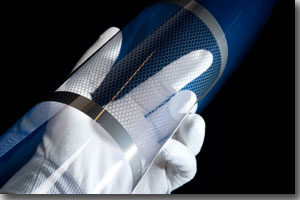DuPont Microcircuit Materials (MCM), part of DuPont Electronics & Communications, has announced a key collaboration with Holst Centre, an independent open-innovation R&D center, focused on printed electronics.
The collaboration is expected to advance technology in the area of printed structures on flexible substrates, which has application in flexible display, radio-frequency identification (RFID), lighting, biomedical and organic photovoltaic (OPV) markets.
 DuPont Microcircuit Materials and Holst Centre are collaborating on innovations for flexible substrates used in displays, lighting and organic photovoltaics.
DuPont Microcircuit Materials and Holst Centre are collaborating on innovations for flexible substrates used in displays, lighting and organic photovoltaics.
"As one of the leading material suppliers to the printed electronics industry, DuPont MCM is pleased to collaborate with Holst Centre to enhance the potential for significant new material developments and accelerate market growth in multiple printed electronics applications,” said Kerry Adams, European business development manager – MCM. “We are honored to be part of such an innovative center of excellence for the advancement of technologies in this exciting area and look forward to collaborative research with other industrial partners.”
DuPont MCM will be joining the Printed Structures on Flexible Substrates program. The work will concentrate on optimizing printed metallic structures on flexible substrates in terms of conductivity, fine line deposition and low energy sintering. A variety of roll-to-roll compatible printing techniques will be studied, including screen, flexography and ink jet. Alternative conductor metallurgies will be studied, as well as reactive systems for depositing conductive traces.
"We are proud to welcome DuPont to the Holst Centre ecosystem,” said Erwin Meinders, program manager Printed Structures on Flexible Substrates – Holst Centre. “DuPont has a strong reputation in functional inks. I'm confident that DuPont's participation in Holst Centre will give a boost to the further advancement of functional inks and conductive pastes, as key enablers for large-area printed electronics applications.”
Source: http://www2.dupont.com/